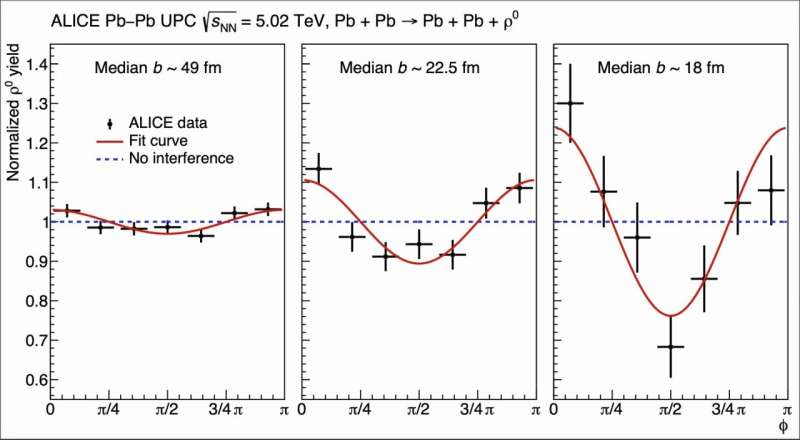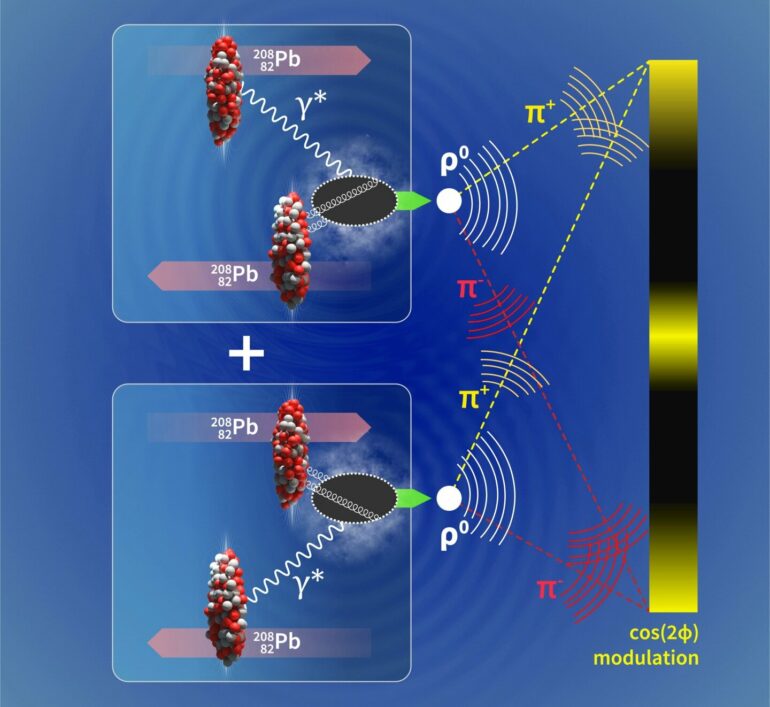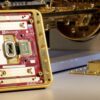In the famous double-slit experiment, an interference pattern consisting of dark and bright bands emerges when a beam of light hits two narrow slits. The same effect has also been seen with particles such as electrons and protons, demonstrating the wave nature of propagating particles in quantum mechanics.
Typically, experiments of this type produce interference patterns at the nanometer scale. In a recent study posted to the arXiv preprint server, the ALICE collaboration has measured a similar interference pattern at the femtometer scale using ultra-peripheral collisions between lead nuclei at the Large Hadron Collider (LHC).
In ultra-peripheral collisions between two heavy nuclei, the nuclei pass close to each other without colliding. Here, the perpendicular distance between the two nuclei—the impact parameter—is larger than the sum of their radii, and one nucleus emits a photon that transforms into a virtual pair composed of a quark and its antimatter partner.
This pair interacts strongly with the other nucleus, resulting in the emission of a type of particle known as a vector meson and in the exchange of two gluons (see figure above). Such vector meson photoproduction is a well-established tool for probing the internal structure of colliding nuclei.
In vector meson photoproduction involving symmetric systems, such as two lead nuclei, it is not possible to determine which of the nuclei emits the photon and which emits the two gluons. Moreover, due to the short-range of the strong force between the virtual quark–antiquark pair and the nucleus, the vector mesons are produced within or close to one of the two well-separated nuclei.
Because of this and their relatively short lifetime, the vector mesons decay quite rapidly into other particles. These decay products form a quantum-mechanically entangled state and generate an interference pattern akin to that of a double-slit interferometer.
In the photoproduction of the electrically neutral rho vector meson (ρ0), the subject of the ALICE collaboration’s recent study, the interference pattern takes the form of a cos(2φ) modulation of the ρ0 yield, where φ is the angle between the two vectors formed by the sum and difference of the transverse momenta of the two oppositely charged pions into which the ρ0 decays. The strength of the modulation is expected to increase as the impact parameter decreases.
Using a dataset of 57,000 ρ0 mesons produced in lead–lead collisions that took place at an energy of 5.02 teraelectronvolts per pair of nucleons (protons and neutrons) during Run 2 of the LHC, the ALICE team measured the cos(2φ) modulation of the ρ0 yield for different values of the impact parameter.
The measurements showed that the strength of the modulation varies strongly with the impact parameter, whose value is of the order of femtometers (see figure below). Theoretical calculations indicate that this behavior is indeed the result of a quantum interference effect at the femtometer scale.

Modulation of the ρ0 meson yield for different median values of the impact parameter (b). © ALICE
In the ongoing Run 3 of the LHC and in the next run, Run 4, ALICE is expected to collect more than 15 million ρ0 mesons from lead–lead collisions. This enhanced dataset will allow a more detailed analysis of the interference effect.
More information:
Measurement of the impact-parameter dependent azimuthal anisotropy in coherent ρ0 photoproduction in Pb–Pb collisions at √sNN = 5.02 TeV, arXiv (2024). DOI: 10.48550/arxiv.2405.14525
Citation:
ALICE measures interference pattern akin to the double-slit experiment (2024, August 12)



